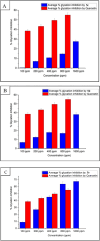Evaluation of In Silico and In Vitro Antidiabetic Properties of 4-(Hydroxysubstituted Arylidene)-2-Phenyloxazol-5(4 H)-one Derivatives
- PMID: 40060839
- PMCID: PMC11886645
- DOI: 10.1021/acsomega.4c09061
Evaluation of In Silico and In Vitro Antidiabetic Properties of 4-(Hydroxysubstituted Arylidene)-2-Phenyloxazol-5(4 H)-one Derivatives
Abstract
Oxazolones are heterocyclic molecules characterized by a five-membered ring containing both nitrogen and oxygen atoms. It is a significant pharmacophore for therapies as well as a synthon for many physiologically active compounds. Since diabetes is a chronic disease that affects how the body metabolizes sugars, the major focus of this study was to evaluate the antidiabetic properties of synthetic 4-( Hydroxysubstituted arylidene)-2-phenyloxazol-5(4 H )-one derivatives in silico and in vitro. Derivatives were synthesized by the Erlenmeyer and Justus method with slight modifications. Structures of the derivatives were confirmed by physical, FTIR, 1H NMR, 13C NMR, and HRMS data. Mainly, the antidiabetic properties were determined via α-amylase inhibitory activity, α-glucosidase inhibitory activity, glycation inhibitory activity, glucose uptake by yeast cell assay, and kinetic studies. The ability of synthesized compounds in the inhibition of α-amylase and α-glucosidase, drug-likeness model score evaluations, possible adverse effects, and ADMET profiles were also investigated by in silico studies. The results indicate that 5e exhibits the highest inhibition toward α-amylase enzyme with a mixed inhibition, while 5b showed the highest inhibition toward α-glucosidase enzyme with a mixed inhibition pattern in the presence of acarbose as the standard drug. In the protein glycation inhibitory assay, 5e demonstrated strong inhibition at higher concentrations, surpassing quercetin. Maximum potential to transport glucose across the cell membrane of Saccharomyces cerevisiae was shown by 5e. Under in silico studies, 5e showed the highest drug-likeness score and the highest affinity for the α-amylase enzyme, while 5d showed the highest affinity toward the α-glucosidase enzyme. These results show a good correlation between in vitro and in silico studies for 5e. Overall, results from both in vitro and in silico studies suggest that the increment of the number of hydroxyl groups in the structure may enhance the activity of 5e and the potential of synthesized oxazol-5(4H)-one derivatives with hydroxyl groups attached to the phenyl ring as promising candidates for the treatment of diabetic mellitus. Further, it suggests that more research is required to validate the efficacy and mechanisms of action of these compounds.
© 2025 The Authors. Published by American Chemical Society.
Conflict of interest statement
The authors declare no competing financial interest.
Figures








Similar articles
-
2,4-Dichloro-5-[(N-aryl/alkyl)sulfamoyl]benzoic Acid Derivatives: In Vitro Antidiabetic Activity, Molecular Modeling and In silico ADMET Screening.Med Chem. 2019;15(2):186-195. doi: 10.2174/1573406414666180924164327. Med Chem. 2019. PMID: 30251608
-
Unveiling anti-diabetic potential of new thiazole-sulfonamide derivatives: Design, synthesis, in vitro bio-evaluation targeting DPP-4, α-glucosidase, and α-amylase with in-silico ADMET and docking simulation.Bioorg Chem. 2024 Oct;151:107671. doi: 10.1016/j.bioorg.2024.107671. Epub 2024 Jul 23. Bioorg Chem. 2024. PMID: 39067419
-
Identification of isobenzofuranone derivatives as promising antidiabetic agents: Synthesis, in vitro and in vivo inhibition of α-glucosidase and α-amylase, computational docking analysis and molecular dynamics simulations.Int J Biol Macromol. 2024 Feb;259(Pt 2):129241. doi: 10.1016/j.ijbiomac.2024.129241. Epub 2024 Jan 8. Int J Biol Macromol. 2024. PMID: 38199537
-
Synthesis and In Silico Analysis of New Polyheterocyclic Molecules Derived from [1,4]-Benzoxazin-3-one and Their Inhibitory Effect against Pancreatic α-Amylase and Intestinal α-Glucosidase.Molecules. 2024 Jun 28;29(13):3086. doi: 10.3390/molecules29133086. Molecules. 2024. PMID: 38999038 Free PMC article.
-
Pyrano[3,2-c]quinoline Derivatives as New Class of α-glucosidase Inhibitors to Treat Type 2 Diabetes: Synthesis, in vitro Biological Evaluation and Kinetic Study.Med Chem. 2019;15(1):8-16. doi: 10.2174/1573406414666180528110104. Med Chem. 2019. PMID: 29807519 Review.
References
-
- Cefalu W. T.; Kaul S.; Gerstein H. C.; Holman R. R.; Zinman B.; Skyler J. S.; Green J. B.; Buse J. B.; Inzucchi S. E.; Leiter L. A.; Raz I.; Rosenstock J.; Riddle M. C. Cardiovascular Outcomes Trials in Type 2 Diabetes: Where Do We Go from Here? Reflections From a Diabetes Care Editors’ Expert Forum. Diabetes Care 2018, 41 (1), 14–31. 10.2337/dci17-0057. - DOI - PMC - PubMed
-
- Holt R. I. G.; DeVries J. H.; Hess-Fischl A.; Hirsch I. B.; Kirkman M. S.; Klupa T.; Ludwig B.; No̷rgaard K.; Pettus J.; Renard E.; Skyler J. S.; Snoek F. J.; Weinstock R. S.; Peters A. L. The Management of Type 1 Diabetes in Adults. A Consensus Report by the American Diabetes Association (ADA) and the European Association for the Study of Diabetes (EASD). Diabetes Care 2021, 44 (11), 2589–2625. 10.2337/dci21-0043. - DOI - PubMed
-
- Egan A. M.; Dinneen S. F. What is diabetes?. Medicine 2019, 47 (1), 1–4. 10.1016/j.mpmed.2018.10.002. - DOI
LinkOut - more resources
Full Text Sources
